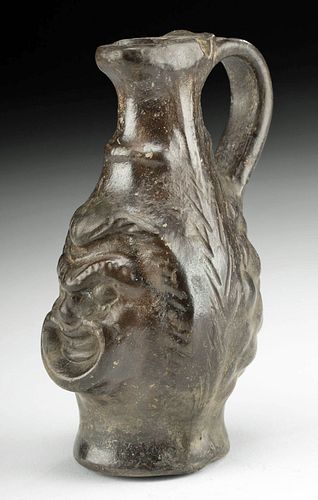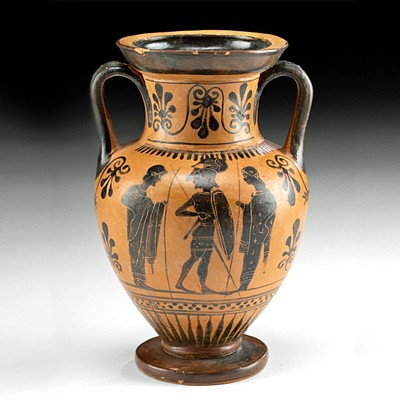Campanian Blackware Aryballos - Greek Comedy Mask, TL'd
Lot 40a
About Seller
Artemis Fine Arts
686 S Taylor Ave, Ste 106
Louisville, CO 80027
United States
Selling antiquities, ancient and ethnographic art online since 1993, Artemis Gallery specializes in Classical Antiquities (Egyptian, Greek, Roman, Near Eastern), Asian, Pre-Columbian, African / Tribal / Oceanographic art. Our extensive inventory includes pottery, stone, metal, wood, glass and textil...Read more
Categories
Estimate:
$4,000 - $6,000
Absentee vs Live bid
Two ways to bid:
- Leave a max absentee bid and the platform will bid on your behalf up to your maximum bid during the live auction.
- Bid live during the auction and your bids will be submitted real-time to the auctioneer.
Bid Increments
| Price | Bid Increment |
|---|---|
| $0 | $25 |
| $300 | $50 |
| $1,000 | $100 |
| $2,000 | $250 |
| $5,000 | $500 |
| $10,000 | $1,000 |
| $20,000 | $2,500 |
| $50,000 | $5,000 |
| $100,000 | $10,000 |
| $200,000 | $20,000 |
About Auction
By Artemis Fine Arts
Mar 9, 2023
Set Reminder
2023-03-09 10:00:00
2023-03-09 10:00:00
America/New_York
Bidsquare
Bidsquare : Exceptional Ancient, Ethnographic, & Fine Art
https://www.bidsquare.com/auctions/artemis-gallery/exceptional-ancient-ethnographic-fine-art-12354
Artemis Fine Arts info@artemisfinearts.com
Artemis Fine Arts info@artemisfinearts.com
- Lot Description
**First Time At Auction**
Magna Graecia, Southern Italy, Campania, ca. late 4th to early 3rd century BCE. An enticing and rare pottery aryballos in the form of a head wearing a theatrical mask that resembles the mask of the "ruler slave" or "first slave" character of the Greek New Comedy period. Crowned by the narrow neck and flared spout of the vessel, the mask presents a huge, open-mouthed smile with lips extending outwards in a trumpet-like fashion just below beady eyes and a furrowed brow, as though angry and happy at the same time, perhaps to represent a type of manic laughter. Some scholars posit that this double-expression mask represents the extreme ability to change expression that seems to be related to the slyness with which slaves were credited. A thick mane of hair surrounds the maddened vizard as a wavy, Nubian-style coiffure envelops the verso, and a trifurcated handle connects the spout to the back of the head. Likely used as a perfume or oil bottle, this is a truly unique and amusing example of Ancient Greek pottery! Size: 3.3" W x 4.8" H (8.4 cm x 12.2 cm)
One of the final three principal dramatic forms in the theatre of classical Greece (the others being tragedy and the satyr play), Ancient Greek comedy is conventionally divided into three periods: Old Comedy, Middle Comedy, and New Comedy. This mask represents a character from the New Comedy period, which followed the death of Alexander the Great in 323 BCE and lasted throughout the reign of the Macedonian rulers, ending about 260 BC. New Comedy is comparable to situational comedy and comedy of manners built around portrayals of daily life and the foibles of recognizable character types. The characters themselves come from a recurring set, often labeled “stock” characters, who come equipped with an identity based primarily on age, gender and social rank. As New Comedy operated in a society where slavery was an institutionalized fact of life and citizenship status and family authority put limitations on marriages, the plays dramatize characters who turn out to have a social rank different what characters initially expect or dramatize negotiations that allow for approved marriages between social ranks.
Masks played an important role in Greek theatre. An actor's entire head and hair would be covered by a large mask of simple design, made from linen or cork, with holes for the mouth and eyes. These masks allowed audience members seated in all areas of the theatre to understand what was happening, while also amplifying the actor's voice. The highly stylized and contorted features of this example are a typical characteristic of theatre masks and allow for easy identification of the characters even from a great distance.
This piece has been published in Gorny and Mosch Auktionskatalog 231, April 8, 2015, lot 423, page 217.
This piece has been tested using thermoluminescence (TL) analysis and has been found to be ancient and of the period stated. A full printed and bound report will accompany the item upon purchase.
Provenance: ex-Royal Athena Galleries, New York City, New York, USA; ex-Gorny & Mosch, Munich, Germany, June 2015; ex-private French collection
All items legal to buy/sell under U.S. Statute covering cultural patrimony Code 2600, CHAPTER 14, and are guaranteed to be as described or your money back.
A Certificate of Authenticity will accompany all winning bids.
We ship worldwide and handle all shipping in-house for your convenience.
#177267Professionally repaired with restoration and repainting in areas. Some light surface wear as shown, but otherwise excellent with nice remaining detail. TL holes to base and under handle near rim.Condition
- Shipping Info
-
All shipping is handled in-house for your convenience. Your invoice from Artemis Gallery will include shipping calculation instructions. If in doubt, please inquire BEFORE bidding for estimated shipping costs for individual items.
-
- Buyer's Premium



 EUR
EUR CAD
CAD AUD
AUD GBP
GBP MXN
MXN HKD
HKD CNY
CNY MYR
MYR SEK
SEK SGD
SGD CHF
CHF THB
THB















